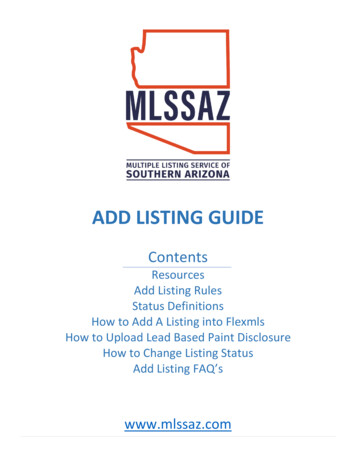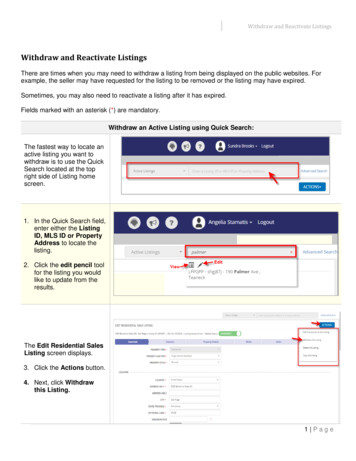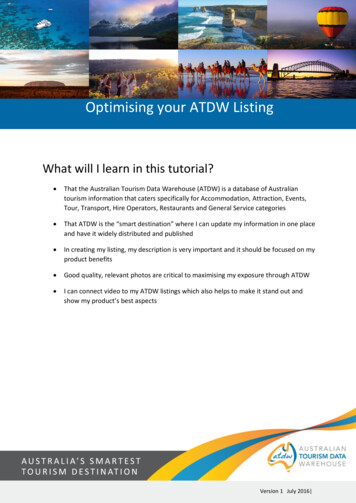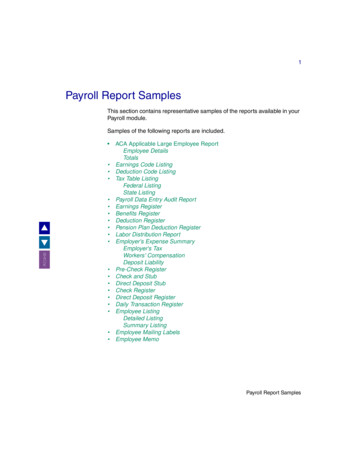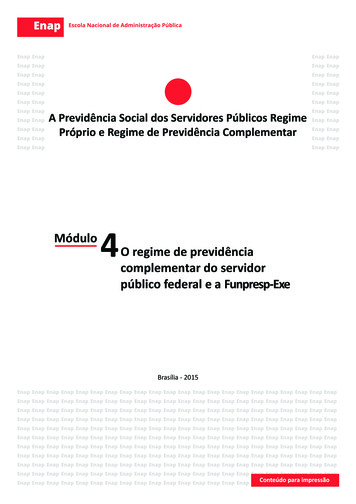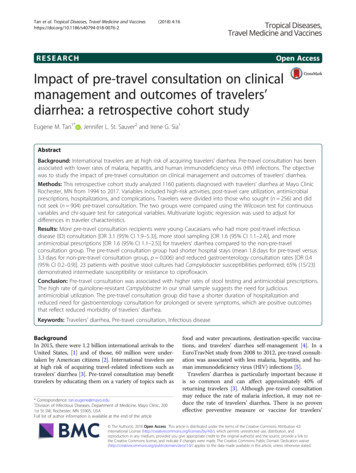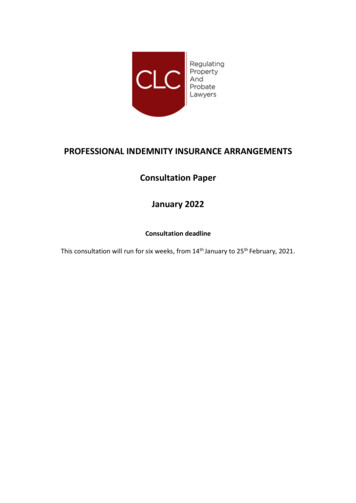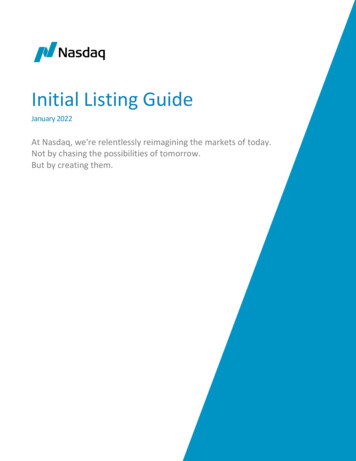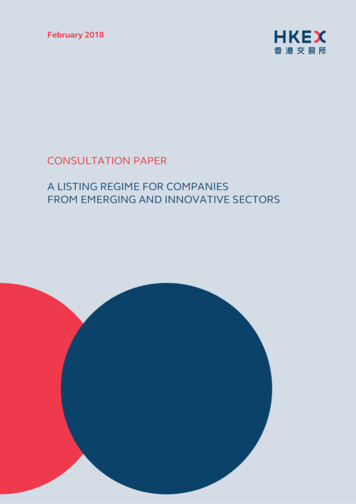
Transcription
February 2018CONSULTATION PAPERA LISTING REGIME FOR COMPANIESFROM EMERGING AND INNOVATIVE SECTORS
TABLE OF CONTENTSPage No.EXECUTIVE SUMMARY. 7CHAPTER 1:INTRODUCTION. 19CHAPTER 2:BIOTECH COMPANIES . 21CHAPTER 3:ISSUERS WITH WVR STRUCTURES . 30CHAPTER 4:SECONDARY LISTINGS OF QUALIFYING ISSUERS . 43CHAPTER 5:REQUEST FOR COMMENT . 52APPENDICESIDRAFT AMENDMENTS TO THE RULESIIPRIVACY POLICY STATEMENT
HOW TO RESPOND TO THIS CONSULTATION PAPERThe Exchange, a wholly-owned subsidiary of HKEX, invites written comments on the matterdiscussed in this paper, or comments on related matters that might have an impact upon thematter discussed in this paper, on or before Friday 23 March 2018.Written comments may be sent:By mail or hand delivery toCorporate and Investor Communications DepartmentHong Kong Exchanges and Clearing Limited12/F, One International Finance Centre1 Harbour View StreetCentralHong KongRe: Emerging and Innovative Companies CPBy fax to(852) 2524 0149By e-mail toresponse@hkex.com.hkPlease mark in the subject line:Re: Emerging and Innovative Companies CPOur submission enquiry number is (852) 2840 3844.Respondents are reminded that we will publish responses on a named basis in the intendedconsultation conclusions. If you do not wish your name to be disclosed to members of thepublic, please state so when responding to this paper. Our policy on handling personal data isset out in Appendix II.Submissions received during the consultation period by Friday 23 March 2018 will be takeninto account before the Exchange decides upon any appropriate further action and aconsultation conclusions paper will be published in due course.DISCLAIMERHKEX and/or its subsidiaries have endeavoured to ensure the accuracy and reliability of theinformation provided in this document, but do not guarantee its accuracy and reliability andaccept no liability (whether in tort or contract or otherwise) for any loss or damage arising fromany inaccuracy or omission or from any decision, action or non-action based on or in relianceupon information contained in this document.
DEFINITIONSTERMDEFINITION“2013 JPS”The Joint Policy Statement Regarding the Listing of OverseasCompanies jointly issued by the SFC and SEHK in September2013 (here)“2014 WVR ConceptPaper”“Weighted Voting Rights Concept Paper”, published in August2014 (here)“2015 WVR ConceptPaper Conclusions”“Consultation Conclusions to Concept Paper on WeightedVoting Rights” published in June 2015 (here)“Authorised Institution”An institution or committee duly authorised or recognised by, orregistered with, a Competent Authority for conducting,assessing and supervising clinical trials in the relevant clinicalfields“Biotech”The application of science and technology to producecommercial products with a medical or other biologicalapplication“Biotech Company”A company primarily engaged in the R&D, application andcommercialisation of Biotech Products (see also Appendix I,Rule 18A.01).“Biotech Product”Biotech products, processes or technologies“CFDA”China Food and Drug Administration“CG Code”Appendix 14 of the Rules – Corporate Governance Code andCorporate Governance Report“close associate”As defined in Rule 1.01“Competent Authority”FDA, CFDA, EMA or any other national or supranationalauthority which the Exchange recognises as a CompetentAuthority on a case by case basis“ControllingShareholder”Any person (including a holder of depositary receipts) who is orgroup of persons (including any holder of depositary receipts)who are together entitled to exercise or control the exercise of30% (or such other amount as may from time to time bespecified in the Takeovers Code as being the level fortriggering a mandatory general offer) or more of the votingpower at general meetings of the issuer or who is or are in aposition to control the composition of a majority of the board ofdirectors of the issuer; or in the case of a PRC issuer, the1
TERMDEFINITIONmeaning ascribed to that phrase by Rule 19A.14 providedalways that a depositary shall not be a controlling shareholdermerely by reason of the fact that it is holding shares of theissuer for the benefit of the holders of depositary receipts“core connected person”As defined in Rule 1.01“Core Product”A Regulated Product that (alone or together with otherRegulated Products) forms the basis of a Biotech Company’slisting application under Chapter 18A of the Listing Rules“Corporate GovernanceCommittee”A committee of the board of an issuer that has the responsibilityfor performing the corporate governance duties set out in theterms of reference of CG Code Provision D.3.1“Country Guides”Guides published on the Exchange’s website setting out,amongst other things, the methods that an issuer incorporatedin a particular jurisdiction can use to meet the Key ShareholderProtection Standards“Dual-Class ShareStructure”Authorised and/or issued share capital that includes twoclasses of shares carrying unequal voting rights at generalmeetings“EMA”European Medicines Agency“Exchange” or “SEHK”The Stock Exchange of Hong Kong Limited“Exchange Participant”A person (a) who, in accordance with the Rules, may trade onor through the Exchange; and (b) whose name is entered in alist, register or roll kept by the Exchange as a person who maytrade on or through the Exchange“FCA”Financial Conduct Authority of the United Kingdom“FDA”US Food and Drug Administration“Financial EligibilityTests”The financial eligibility requirements of the Main Board, being:(i)Rule 8.05(1)(a) (profit test);(ii)Rule 8.05(2)(d), (e) and (f) (the marketcapitalisation/revenue/cash flow test); or(iii)Rule 8.05(3)(d) and (e) (the marketcapitalisation/revenue test)of the Rules2
TERMDEFINITION“Foreign Private Issuer”A term defined under Rule 405 of Regulation C of the U.S.Securities Act of 1933, as amended from time to time, and Rule3b-4 of the U.S. Securities Exchange Act of 1934, as amendedfrom time to time. The term refers to an issuer incorporated ororganised under the laws of a foreign country, except an issuermeeting both of the following conditions:(i)more than 50 per cent. of the outstanding votingsecurities of the issuer are directly or indirectly heldof record by residents of the United States; and(ii)any one of the following:a. the majority of the executive officers or directorsof the issuer are United States citizens orresidents;b. more than 50 per cent. of the assets of theissuer are located in the United States; orc. the business of the issuer is administeredprincipally in the United States.“Grandfathered GreaterChina Issuers”Greater China Issuers that were primary listed on a QualifyingExchange on or before the publication of the New BoardConcept Paper Conclusions (15 December 2017)“Greater China Issuer”A Qualifying Issuer with a “centre of gravity” in Greater China asset out in the definition of “Greater China Issuer” (Appendix I,Rule 19C.01)“HKEX”Hong Kong Exchanges and Clearing Limited“HKSCC”Hong Kong Securities Clearing Company Limited“INED”Independent non-executive director“IPO”Initial public offering“Key ShareholderProtection Standards”The shareholder protection standards set out in Section 1 of the2013 JPS (here), which in summary comprise:(i)(ii)(iii)super-majority vote of members is required toapprove fundamental matters (material changes toconstitutional documents, variation of rightsattached to any class of shares and voluntarywinding-up);no alteration to the constitutional documents toincrease an existing member’s liability unlessapproved by such member;appointment, removal and the remuneration ofauditors require the approval of a majority of3
TERMDEFINITION(iv)(v)(vi)shareholders or other body independent of theboard of directors;issuer must hold an annual general meeting at leastevery 15 months, give reasonable notice ofmeetings and members to have the right to speakand vote at the shareholders’ meeting;minority shareholders must be allowed to convenean extraordinary general meeting (the level ofmembers’ support required to convene a meetingmust not be higher than 10%); andHKSCC must be able to appoint proxies.“Listing Committee”A committee of the SEHK board of directors that exercises allthe powers and functions of the board in relation to listingmatters“Listing Documents”A Prospectus, a circular or any equivalent document (includinga scheme of arrangement and introduction document) issuedor proposed to be issued in connection with an application forlisting“Listing Rules” or“Rules”The Rules Governing the Listing of Securities on SEHK (MainBoard unless otherwise stated)“LSE”London Stock Exchange plc“Main Board”The main board of the SEHK“NASDAQ”Nasdaq Stock Market“New Board ConceptPaper”The Concept Paper on a New Board published on16 June 2017 (here)“New Board ConceptPaper Conclusions”The Conclusions to the New Board Concept Paper publishedon 15 December 2017 (here)“Non-GrandfatheredGreater China Issuers”Greater China Issuers that are primary listed on a QualifyingExchange after the publication of the New Board ConceptPaper Conclusions“Non-Greater ChinaIssuer”A Qualifying Issuer that is not a Greater China Issuer“Non-WVR Shareholder”A holder or beneficiary of the listed shares of an issuer with aWVR structure who is not also a beneficiary of WVR“NYSE”New York Stock Exchange LLC4
TERMDEFINITION“Overseas Issuer”An issuer incorporated or otherwise established outside HongKong“Phase I clinical trials”Clinical trials on human subjects categorised as Phase I clinicaltrials by the FDA (or an equivalent process regulated byanother Competent Authority)“Phase II clinical trials”Clinical trials on human subjects categorised as Phase IIclinical trials by the FDA (or an equivalent process regulated byanother Competent Authority)“PRC” or “Mainland”The People’s Republic of China“Prospectus”A prospectus as defined under Companies (Winding Up andMiscellaneous Provisions) Ordinance (Cap 32. of the Laws ofHong Kong)“Qualifying Exchange”NYSE, NASDAQ or the Main Market of the LSE (and belongingto the FCA’s “Premium Listing” segment)“Qualifying Issuer”An issuer primary listed on a Qualifying Exchange“Regulated Product”A Biotech Product that is required by applicable laws, rules orregulations to be evaluated and approved by a CompetentAuthority based on data derived from clinical trials (i.e. onhuman subjects) before it could be marketed and sold in themarket regulated by that Competent Authority“R&D”Research and development“SFC”Securities and Futures Commission“SFO”Securities and Futures Ordinance (Cap. 571 of the Laws ofHong Kong)“SMLR”Securities and Futures (Stock Market Listing) Rules (Cap.571V of the Laws of Hong Kong)“Sophisticated Investor”An investor that the Exchange considers to be sophisticated byreference to factors such as net assets or assets undermanagement, relevant investment experience, and theinvestor’s knowledge and expertise in the relevant field“Takeovers Code”The Codes on Takeovers and Mergers and Share Buy-backs“US”United States of America5
TERMDEFINITION“VIE Guidance”Guidance issued by the Exchange entitled “Guidance on listedissuers using contractual arrangements for their businesses”,HKEX-GL77-14.“VIE Structure”“Variable Interest Entity Structures” or “Structured Contracts”that allow a foreign company to control and receive theeconomic benefits of a company owning assets or operating inan industry sector that is subject to foreign investmentrestrictions.“WVR”Weighted voting rights“WVR Companies”Companies with a WVR structure“WVR structure”A structure that results in any party having WVR6
EXECUTIVE SUMMARYPurpose1.This consultation paper sets out proposals to expand the existing listing regime tofacilitate the listing of companies from emerging and innovative sectors, subject toappropriate safeguards.2.This consultation paper seeks comments on the proposals and proposed amendmentsto the Rules to allow the listing on the Main Board of:(a)Biotech Companies that do not meet any of the Financial Eligibility Tests,including companies that do not have any prior record of revenue or profit (seeChapter 2);(b)high growth and innovative companies that have WVR structures (see Chapter3); and(c)Qualifying Issuers seeking a secondary listing on the Exchange (see Chapter 4).SummaryIntroduction3.The New Board Concept Paper was published on 16 June 2017, pursuant to a holisticreview by the Exchange, which identified certain gaps within Hong Kong’s listingregime affecting its overall competitiveness versus other major global listing venues,particularly in respect of attracting companies from emerging and innovative sectors 1.4.Drawing on the feedback received in response to the New Board Concept Paper andsubsequent regulatory discussions with the SFC, the Exchange determined in the NewBoard Concept Paper Conclusions (published on 15 December 2017) to proceed toexpand the existing listing regime by introducing two new chapters to the Rules toallow the listing of (a) Biotech Companies which do not meet the Financial EligibilityTests; and (b) innovative and high growth issuers that have WVR structures, subject toadditional disclosure and safeguards 2. The Exchange also proposed to modify theexisting Rules in relation to overseas companies (and make consequential changes tothe 2013 JPS) to create a new secondary listing route to attract innovative issuers thatare primary listed on a Qualifying Exchange.5.The Exchange has further refined the views it set out in the New Board Concept PaperConclusions through discussions with the SFC and stakeholders, and is nowpresenting, for comment, its proposals in detail and proposed amendments to theRules to give effect to the way forward set out in the New Board Concept PaperConclusions.Biotech Companies6.We propose to allow listing of Biotech Companies that do not meet the Financial1The New Board Concept Paper is available here.The New Board Concept Paper Conclusions are available here. In drafting the proposals on WVRCompanies, the Exchange also referred to the 2015 WVR Concept Paper Conclusions.27
Eligibility Tests (including companies with no revenue or profit) whilst providingappropriate investor protection from the risks associated with such companies. TheExchange proposes to do so through the addition of a new Biotech chapter of theRules, supplemented with guidance on the factors that the Exchange will take intoaccount when determining an applicant’s eligibility and suitability to list without meetingthe Financial Eligibility Tests.7.In the US, Biotech Companies make up a majority of companies seeking a listing in theearly stage of the company’s development and the development of the company’sBiotech Products. 3 Regulation by internationally recognised bodies such as the FDAand the stages involved in their approval process provide an indication as to the natureof Biotech Companies, and their development progress, in the absence of traditionalindicators such as revenue and profit. This provides investors with a frame ofreference to form their own judgement about a Biotech Company’s value.Suitability to list8.We propose that a new Biotech Company applicant be expected to demonstrate thefollowing features:(a)the Biotech Company must have developed at least one Core Product beyondthe concept stage. The Exchange would consider a Core Product to have beendeveloped beyond the concept stage if it has met the developmental milestonesspecified for the relevant type of product (see paragraph 75);(b)it must have been primarily engaged in R&D for the purposes of developing itsCore Product(s);(c)it must have been engaged with the R&D of its Core Product(s) for a minimum of12 months prior to listing;(d)it must have as its primary reason for listing the raising of finance for R&D tobring its Core Product(s) to commercialisation;(e)it must have durable patent(s), registered patent(s), patent application(s) and/orintellectual property in relation to its Core Product(s);(f)if the applicant is engaged in the R&D of pharmaceutical (small molecule drugs)products or biologic products, it must demonstrate that it has a pipeline of thosepotential products; and(g)it must have previously received meaningful third party investment (being morethan just a token investment) from at least one Sophisticated Investor at least sixmonths before the date of the proposed listing (which must remain at IPO) 4.3Source: Bloomberg (data as of 29 December 2017). The analysis includes all US listed companiessince 1 January 2012 that are in the early stage of development. Early stage of development is definedby reference to those companies which are unable to meet any of the Financial Eligibility Tests. Biotechcompanies in this paragraph 7 are defined using the Global Industry Classification Standard (GICS) andincludes all industries in the health care sector except health care providers & services.4This factor is intended to demonstrate that a reasonable degree of market acceptance exists for theapplicant’s R&D and Biotech Product. The Exchange may not require compliance with this factor wherethe applicant is a spin-off from a parent company if the applicant is able to otherwise demonstrate to the8
9.The Exchange will recognise the FDA, the CFDA and the EMA as CompetentAuthorities for the purpose of the new Biotech chapter. The Exchange may, at itsdiscretion, recognise other national or supranational authorities as CompetentAuthorities in individual cases (depending on the nature of the Biotech Product). TheExchange will seek the SFC’s consent before making such a recognition.Expected Market Capitalisation10.We propose that Biotech Company applicants must have a minimum expected marketcapitalisation at the time of listing on the Exchange of HK 1.5 billion. This will likelylimit applicants to those that have achieved a higher degree of investment frompre-IPO investors on the basis of confidence that the company and its managementhave the capability to achieve success in their R&D activities.Enhanced Disclosure Requirements11.12.Biotech Companies applying for a listing will be required to provide prominent warningstatements and enhanced risk disclosures. This will include disclosures on:(a)the phases of development for its Core Product(s);(b)material communications with all relevant Competent Authorities in relation to itsCore Product(s) (unless disclosure is restricted under applicable laws orregulations or the direction of the Competent Authority);(c)all material safety data relating to its Core Product(s);(d)the immediate market opportunity and any potential increased marketopportunity of its Core Product(s);(e)its rights and obligations in respect of any in-licensed Core Products;(f)disclosure of operating costs, capital expenditure and working capital includingdetails of spending on R&D;(g)patents granted, registered and applied for and other intellectual propertiesrelating to the Core Product(s) (unless the applicant is able to demonstrate to thesatisfaction of the Exchange that such disclosure would require the applicant todisclose highly sensitive commercial information); and(h)the R&D experience of management.Biotech Companies will also be required to provide ongoing disclosures regarding theirR&D activities in their interim and annual reports.Restriction on Cornerstones13.The Exchange proposes that shares subscribed by cornerstone investors should notcount towards determining whether a Biotech Company has met the minimum initialpublic float requirement at the time of listing and at all times prior to the expiry of thesix-month lock up period applicable to cornerstone investors from the date of listing.The proposed restriction on cornerstone investors will help reduce the influence ofpre-arranged deals on the book-building process and will also help ensure that theExchange’s satisfaction that a reasonable degree of market acceptance exists for its R&D and BiotechProduct (for example, in the form of collaboration with other established R&D companies).9
pricing process for the IPOs of such companies is as market-driven as possible.14.Existing shareholders of the applicant may subscribe for shares in the IPO to avoid adilution to their shareholdings under the existing regulatory framework 5. Where anexisting shareholder does not meet the conditions under the existing guidance, theExchange is proposing to allow such a shareholder to participate in the IPO of aBiotech Company as a cornerstone investor. Shares subscribed by existingshareholders in the IPO will not be counted towards determining whether the BiotechCompany has met the minimum initial public float requirement but any shares held byexisting shareholders prior to the IPO will be counted towards the public float providedthat the existing shareholder is not a core connected person or otherwise notrecognised by the Exchange to be a member of the public in accordance with Rule8.24 6.Material Change of Business and De-listing Process15.Given their nature, there are concerns that Biotech Companies listed under theBiotech chapter may become shell companies if they do not achieve their businessplans and hence targets for attempts to list new assets or businesses in circumventionof the listing requirements for new applicants. Accordingly the Exchange proposes torestrict a Biotech Company listed under the new Biotech chapter from effecting anytransaction that will result in a fundamental change to its principal business without theprior consent of the Exchange. Biotech Companies listed under the Biotech chapterwhich fail to meet the continuing obligation under the Rules to maintain sufficientoperations or assets would be given a period of up to 12 months to re-comply with thisrequirement, failing which the Exchange will cancel its listing. The Exchange willrequire Biotech Companies listed under the Biotech chapter to be prominentlyidentified through a unique stock marker “B” at the end of their stock name to helpinvestors to differentiate them from other listed issuers. A Biotech Company which hasdeveloped its business and is able to demonstrate to the Exchange that it is able tosatisfy one of the Financial Eligibility Tests will no longer be subject to these measures.Issuers with WVR Structures16.56The Exchange believes that the “one-share, one vote” principle continues to be theoptimum method of empowering shareholders and aligning their interests in acompany. The main objective behind the proposal to expand the listing regime to allowWVR structures is to attract good quality and high growth companies from innovativesectors to list in Hong Kong. Consequently, the Exchange will consider allcircumstances in exercising its discretion to find an applicant suitable to list with aWVR structure and will do so only in appropriate cases where the applicant fits theprofile of companies targeted by the proposed regime. Demonstration of any or all ofthe characteristics specified in the relevant listing guidance may not of itself ensure anSee Guidance Letters HKEX-GL-43-12 and HKEX-GL-85-16.Rule 8.24 provides that the Exchange will not recognise as a member of “the public”:(1)any person whose acquisition of securities has been financed directly or indirectly by a coreconnected person;(2)any person who is accustomed to take instructions from a core connected person in relation tothe acquisition, disposal, voting or other disposition of securities of the issuer registered in hisname or otherwise held by him.10
applicant’s suitability to list with a WVR structure.17.The Exchange proposes to implement a new Chapter 8A of the Rules setting out thequalifications for listing of companies with a WVR structure and the safeguards thatthey must put in place to protect investors on an ongoing basis, supplemented withguidance on the factors that the Exchange will take into account when assessingwhether such an applicant is eligible and suitable for listing with a WVR structure.Companies Suitable to List with a WVR Structure18.The Exchange proposes that a company would normally be considered suitable forlisting in Hong Kong with a WVR structure if it is able to demonstrate the characteristicsset out below. However, the Exchange would retain absolute discretion to reject anapplication for listing with a WVR structure even if the applicant meets theserequirements to ensure only “bona fide” candidates who fit the target profile are listed.(a)Nature of the company: the applicant must be an innovative company. TheExchange considers that an innovative company for the purpose of the Ruleswould normally be expected to possess more than one of the followingcharacteristics: its success is demonstrated to be attributable to the application, to thecompany’s core business, of (1) new technologies; (2) innovations; and/or (3)a new business model, which also serves to differentiate the company fromexisting players; R&D is a significant contributor of its expected value and constitutes a majoractivity and expense; its success is demonstrated to be attributable to its unique features orintellectual property; and/or it has an outsized market capitalisation / intangible asset value relative to itstangible asset value.The Exchange recognises that what is considered “innovative” depends on thestate of the industry(ies) and market(s) in which an applicant operates, and willchange over time as technology, markets and industries develop and change.For example, a new and “innovative” business model may cease to be so if it isadopted by numerous industry players over time. Conversely, a company maydevelop an “innovative” way of deploying existing technologies that qualifies it forlisting with a WVR structure. Accordingly, the fact that a particular company hasqualified for listing with a WVR structure does not necessarily mean that anotherapplicant with a similar technology, innovation or business model will also qualifyfor listing with a WVR structure.The Exchange will review the facts and circumstances of each case to determineif an applicant has demonstrated that it is an innovative company for the purposeof this sub-paragraph (a). The superficial application of new technology to anotherwise conventional business will not be sufficient to demonstrate thecharacteristics set out above. So, for example, the Exchange may consider thatan applicant that operates a retail business with an online sales platform may notbe suitable to list with a WVR structure if it does not exhibit other distinctivefeatures or characteristics.11
(b)Success of the company: the applicant must demonstrate a track record of highbusiness growth, as can be objectively measured by operational metrics such asbusiness operations, users, customers, unit sales, revenue, profits and/ormarket value (as appropriate) and its high growth trajectory is expected tocontinue.(c)Contribution of WVR beneficiaries: Each WVR beneficiary must have beenmaterially responsible for the growth of the business, by way of his skills,knowledge and/or strategic direction in circumstances where the value of thecompany is largely attributable or attached to intangible human capital.(d)Role of WVR beneficiaries:(e)(i)each WVR beneficiary must be an individual who has an active executiverole within the business, and has contributed to a material extent to theongoing growth of the business; and(ii)each WVR beneficiary must be a director of the issuer at the time of listing.External validation: the applicant must have previously received meaningful thirdparty investment (being more than just a token investment) from at least oneSophisticated Investor (which must remain at IPO). Such investors will berequired to retain an aggregate 50% of their investment at the time of listing for aperiod of at least six months post-IPO (subject to exceptions for de minimisinvestments by specific investors provided that the main investors are incompliance). The Exchange would not normally require an applicant todemonstrate that it has received meaningful third party investment if theapplicant is a spin-off from a parent company. 7Expected Market Capitalisation19.In addition to satisfaction of the relevant criteria under Rule 8.05 (or draft Rule 18A.03in the case of a Biotech Company eligible for listing under Chapter 18A), the Exchangeproposes initially to limit applicants permitted to list with WVR structures to thosecompanies that have an expected market capitalisation at listing of not less thanHK 10 billion. If an applicant with a WVR structure has an expected marketcapitalisation at listing of less than HK 40 billion, the Exchange will also require theapplicant to have at least HK 1 billion of revenue in its most recent audited financialyear. This requirement is intended to limit applicants to established and high profilecompanies that have already received substantial investment from at least oneSophisticated Investor.Ring-fencing20.Only new applicants will be able to list with a WVR structure and the Exchange willseek to ensure that companies do not use artificial means to circumvent this and otherrestrictions. Any circumvention of or non-compliance with a requirement under theregime for WVR structures may also amount to a contravention of the SMLR and, inthese circumstances, the SFC may exercise its powers under the SMLR in relation to7For the purpose of assessing the eligibility and suitability of an applicant to list with a WVR structure, aspin-off applicant will be assessed on a stand-alone basis separate from the characteristics and trackrecord of the parent (irrespective of whether the parent is listed on the Exchange or overseas).12
the
3b-4 of the U.S. Securities Exchange Act of 1934, as amended from time to time. The term refers to an issuer incorporated or organised under the laws of a foreign country, except an issuer meeting both of the following conditions: (i) more than 50 per cent. of the outstanding voting securities of the issuer are directly or indirectly held

